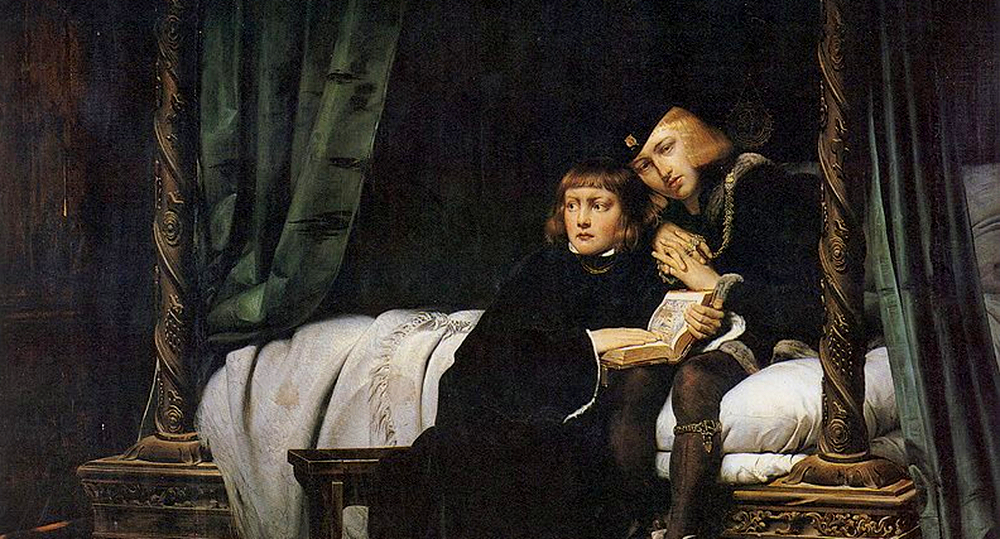On the 26th of June 1483 Richard Duke of Gloucester ascended to the throne as King Richard III. Almost five centuries have passed since the nephews he deposed to take the throne disappeared from the Tower of London. Their fate remains a mystery to this day. In seeking to exonerate Richard III of the crime of murdering his nephews the list of suspects has grown longer and more unlikely. Edward V and Richard Duke of York were not only the nephews of Richard III, they were the nephews of the Duke of Buckingham, the brothers-in-law of Henry VII and his mother Margaret Beaufort’s relations by marriage. Instead of seeking to blacken the names of those we think may have had more advantage in murdering two children, perhaps we need to take a step back and look at the evidence. For there is still no evidence that a murder took place at all.
There are few historians who dare to break from a centuries-old tradition. Today we are joined by best-selling authors David Baldwin, Annette Carson, Toni Mount and Josephine Wilkinson to discuss the fate of the Princes in the Tower.
Why do you think there is so much doubt surrounding the possibility that Edward V and Richard Duke of York may have survived, considering we have no concrete evidence of a murder?
David Baldwin: Because they disappeared completely and without explanation. People need to see bodies (or nowadays, pictures of bodies), and neither Richard III nor Henry VII could apparently produce the boys, alive or dead. No survival myths grew up around King Richard after his corpse had been put on public display.
Annette Carson: People’s attitudes have varied since the beginning. The official Tudor party line was doubted at the time – probably because a lot of the circumstantial detail didn’t match the personal recollections of people who were around in 1483. But over time the reverence for Shakespeare (and Thomas More) became stronger than rational doubt. In recent times, since ‘History’ became a subject of academic study, historians like James Gairdner and his successors have felt they needed to produce judgements rather than admit there is still an awful lot that simply cannot be known.
Toni Mount: Maybe it’s because people like More and Shakespeare have written such compelling stories with Richard as a charismatic villain – people find it easy to believe he was a child-murderer.
Josephine Wilkinson: As I say in my book, the rumour that Richard III murdered Edward V and Richard of York was spread by those involved in the summer and autumn rebellions against the king, specifically, Margaret Beaufort and John Morton. Their allegiance to Margaret’s son, Henry Tudor, and their desire to bring him to England to unseat Richard and take the throne meant that good reasons had to be found to make people rally to his cause. What better way than to portray Richard as a child murderer? Also, to many, it would make sense for Richard to murder his nephews, so it was assumed that he did just that. Finally, many of the sources in which Richard is accepted as murdering the Princes came from authors whose integrity ensured they would be listened to and believed. It’s only when we start to apply scholarly critique to these sources that we begin to see that the evidence is not so convincing.
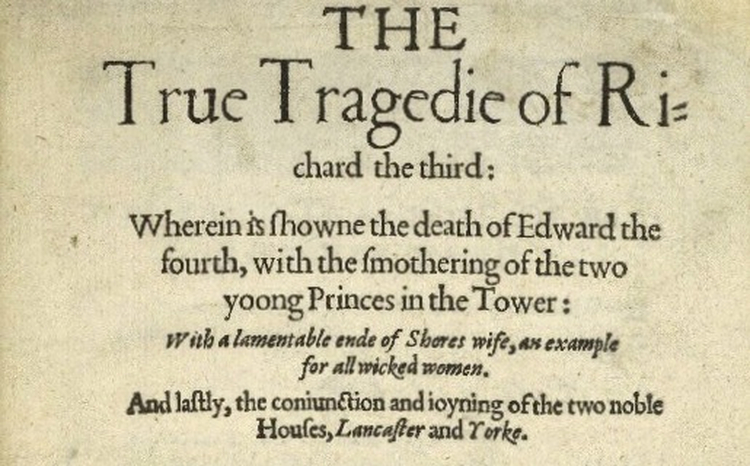
Has there been any real new developments over the centuries or are we generally relying on the same sources?
David Baldwin: We have always lacked – and still lack – a letter or narrative written by someone who was close enough to the court to possess reliable information and who was prepared to share his or her thoughts. Those who almost certainly did know, Richard, Henry, Margaret Beaufort, Elizabeth of York etc, kept their knowledge strictly to themselves.
Annette Carson: There have been myriads of new developments over the centuries, sources have been found, voices have suggested new theories. But the only categorical story is the old one produced by More and Shakespeare. The problem comes with interpretations. A very good example is Dominic Mancini’s report, discovered in the 1930s. Mancini, returning to France from London in 1483 (and no admirer of Richard III), stated in December that he had tried but failed to find out whether Edward V had died. Yet I’ve seen it claimed that Mancini was the informant of the French Chancellor who publicly announced in January that Edward was murdered. Other historians when quoting this section of Mancini have chosen to omit these particular words. What good are new discoveries if they are deliberately misinterpreted?
Toni Mount: New sources have been found in the Burgundian, Irish and Vatican Archives, many of them still to be studied in detail.
Josephine Wilkinson: Historians rely on sources that have been available for centuries, many of which appeared in Richard III’s own lifetime. It is essential to know them thoroughly and look at them objectively. If we arrange the very earliest sources strictly into the order in which they appeared, and look at who said what, when and where, then a picture emerges of how the rumour of the Princes’ deaths came about. It is possible, as I have done, to trace the origin of the rumour and the purpose it served.
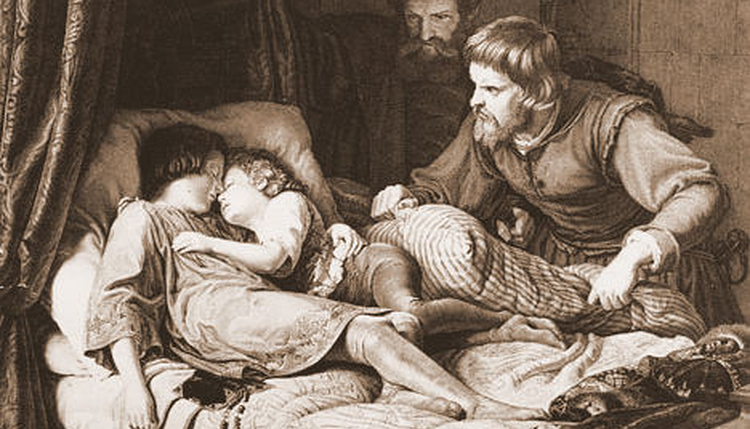
What do you think is the most important factor in the possibility that the boys may have survived after they disappeared?
David Baldwin: We have to ask ourselves if Richard would have killed his brother’s sons, or Henry Tudor his brothers-in-law, when a more humane solution was available. Hiding the boys, giving them new identities, would have allowed both rulers to salve their consciences, but left them powerless to scotch rumours that they had had them killed.
Annette Carson: I strongly believe they were moved with the goal of hiding them in Flanders: to that extent I believe they survived their stay in the Tower. Unfortunately I think what became of them after that relies on conjecture, mainly because it has not been considered worth serious research.
Toni Mount: The involvement and high status of people active in the Lambert Simnel and Perkin Warbeck rebellions – people who would have known the princes personally. I don’t think Richard had a good enough reason to kill them once the boys were officially illegitimate. Incidentally, unlike some of my colleagues on the Richard III Society research committee, I don’t believe Henry VII killed them either although he would have had to, if he found them alive in the Tower, because he had re-legitimised the family so he could marry their sister Elizabeth. Henry wanted the chief rebels taken alive after the Simnel rebellion so they could unravel the mystery of their little ‘king’ for him and later he had his spies rushing covertly around Europe, trying to discover Warbeck’s true identity – something he wouldn’t have had to worry about if he had killed the princes himself.
Josephine Wilkinson: For me, the most convincing factor lies in the rumour that they had been murdered – its place of origin and the trajectory of its spread.
What is your opinion on the remains allegedly belonging to the boys in the urn in Westminster Abbey?
David Baldwin: I think we should keep an open mind until the bones can be re-examined using modern technology. If they are not the remains of the Princes then all other possibilities remain open, but if they are we will have to accept that neither boy survived for long.
Annette Carson: My survey in The Maligned King is considered by many to be the most comprehensive since Hammond & White in 1986. They and I agree that there is no convincing item of evidence, either historical, logistical or scientific, to connect them in any way with the sons of Edward IV. They could equally well be female remains (and could be pre-Norman).
Toni Mount: I very much doubt those remains are the princes’. The only reason to think they could be is Thomas More’s assertion that they were buried ‘meetly deep’ beneath a stair which is just where the bones were discovered. However, if you read More’s next sentence, he states that Richard’s conscience pricked him and he ordered the bodies to be taken for proper burial in consecrated ground, so, no, unless someone defied the king in this matter, those bones aren’t the princes’.
Josephine Wilkinson: The key word here is allegedly. There is no proof that the bones belong to the Princes, nor is there proof that they do not! There is still some mystery surrounding these remains. The only solution, really, would be to perform DNA tests on the bones in order to establish, as far as possible, their sex and their age at death. Then again, even if it could be shown beyond any doubt that the bones are those of the Princes, DNA testing could not establish whether or not they were murdered and if so, by whom.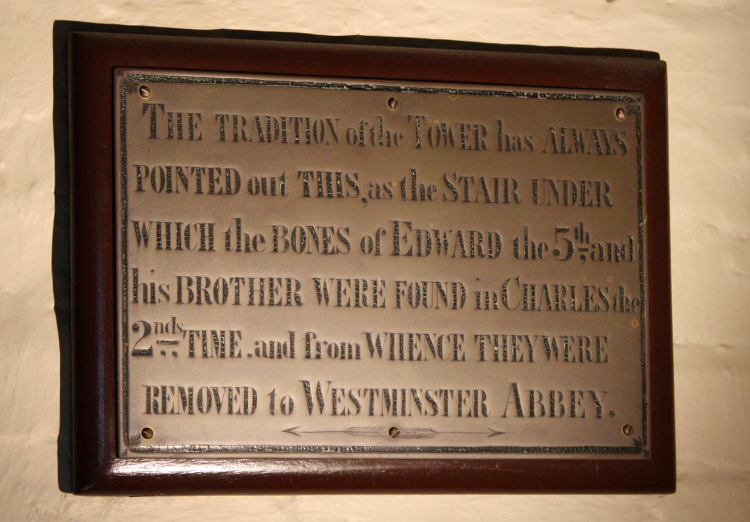
How many of their contemporaries believed they may have survived?
David Baldwin: Not many, I imagine. Everyone who took an interest in these matters knew – or thought they knew – what had happened to Edward II, Richard II, and Henry VI after their depositions, and the logical conclusion was that Edward V and his brother would share their fate. We do not know if the foreign rulers who backed Perkin Warbeck believed he was genuine or merely used him to make trouble for Henry VII.
Annette Carson: In 1484 Niclas von Popplau said in his private diary that ‘many people believed’, and he agreed with them, that they were alive and hidden away. We don’t know how many people took this view, but it was echoed by several other writers.
In the 1490s the young man known to history as ‘Perkin Warbeck’ was widely believed to be Richard of York and caused considerable concern to Henry VII, to the extent that in 1495 he beheaded Sir William Stanley for conceding that ‘Perkin’ could have been the genuine article.
In about 1500 Jean Molinet took an interest in their fate, and was quoted as saying he believed that one brother died and one survived.
In 1503 Henry VII’s official biographer, Bernard André, mentioned rumours of their survival.
In the later printed version of Vergil’s Anglica Historia he stated that it was generally reported and believed that they were still alive, ‘having been conveyed secretly away and obscurely concealed in some distant region’.
Toni Mount: John, Earl of Lincoln (Richard III’s heir); Francis, Viscount Lovell (Richard’s Chamberlain); Sir William Stanley (who had a lot to lose in supporting Warbeck and was executed for his involvement); a number of Irish lords & European heads of state.
Josephine Wilkinson: This is impossible to say. Many would have believed they were dead simply because they had been told so or because it was a logical assumption. Others would have suspected they were not dead – or at least had not been killed by Richard III. Still others, the vast majority in fact, would probably have kept their own counsel and said nothing – discretion being the better part of valour! However, only a tiny few would have known the truth, and only as far as was necessary to ensure the safety of the boys.
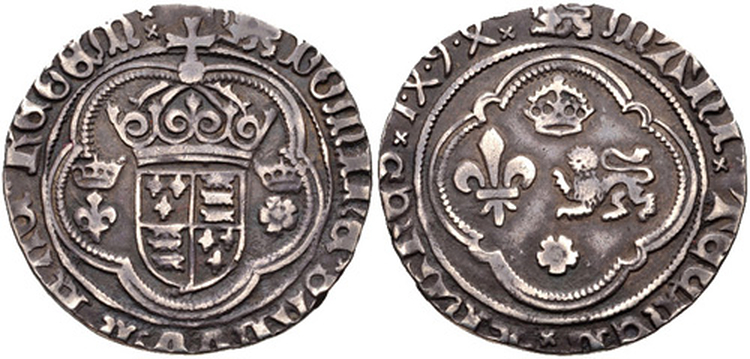
Do you think that the later rumours of their survival and the belief that Perkin Warbeck was actually Richard Duke of York is significant?
David Baldwin: Warbeck was a plausible imposter inasmuch as he apparently resembled his ‘father’ Edward IV and never betrayed himself by his ignorance: but he refused to reveal what had happened to him between 1483 and his reappearance in Ireland in 1491. His ‘excuse’ was that he had to shield those who had protected him, but it could have been a means of ducking the one question everyone was bound to ask.
Annette Carson: Any view that departed from orthodoxy under the Tudors was dangerous, so Englishmen who publicly put views forward about ‘Perkin’ being Richard of York were taking a risk. Foreign heads of state might have had ulterior motives, but evidence suggests that royalty in Spain and Scotland genuinely believed he was Richard. And Henry VII made his son (or sons) disappear. For these and other reasons he ought to be taken seriously … although he could have been a bastard son of Edward IV or Clarence.
Josephine Wilkinson: Yes. I believe it probable that Edward V died, either within the Tower or very soon after leaving it. Whether he died of illness or through an accident I cannot say, but I really don’t think he was murdered. After all, why murder Edward and leave Richard of York alive? Of course, there were sound political reasons why Warbeck would be accepted as Richard of York by rulers of other European countries, including Scotland. They had their own reasons to oppose Henry VII. However, if it were known that both boys were dead, there would be little point in pretending to be Richard of York. No political intrigue would have been taken seriously if there had been no doubt as to his fate. On the other hand, it is just possible that Perkin was Richard, although I have my doubts.
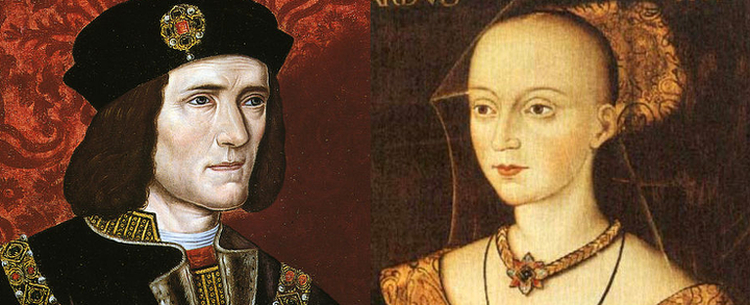
Considering the possibility that they boys had been smuggled out of the Tower to safety, do you think this was arranged by Richard III, their mother Elizabeth Woodville, or perhaps they came to an agreement?
David Baldwin: King Richard’s relations with Elizabeth Woodville appear to have improved markedly after she left sanctuary in 1484. She even encouraged her eldest son Dorset to surrender to him notwithstanding the recent executions of her brother Anthony and younger son Richard Grey. A secret agreement that preserved the life of at least one of the Princes could have been at the heart of this.
Annette Carson: My theory is that they were moved openly, not smuggled secretly. And that this was done around September 1483 (otherwise that month’s rumour of their death would have been rather easily disproved!). At this time Elizabeth Woodville and her family were busily stirring up rebellion, i.e. trying to kill him, so the idea of Richard reaching an agreement with her – and while he was at the other end of the country – is not likely. For the boys’ safety the arrangements needed to be a matter for the minimum number of people.
Toni Mount: Richard was most likely the instigator. Elizabeth Woodville may well have been told but wasn’t really in a position to arrange anything.
Josephine Wilkinson: I think the most probable scenario is that Richard arranged his nephews’ disappearance. The plan had to be carried out in conditions of the strictest secrecy in order to ensure its success. Richard was then in a position to persuade Elizabeth Wydeville that the rumours she might have heard about the murder of her sons were not true.
What do you think of the family legend that the boys were living at Sir James Tyrell’s seat of Gipping Hall with their mother?
David Baldwin: This is a family tradition and as such, ultimately unverifiable. But there is seldom smoke without fire, even if the story has gained with the telling. It would be strange if the man who was later accused of murdering the Princes had actually been their protector, but nothing can be ruled out.
Annette Carson: The tradition need not mean anything as specific as it sounds: later generations could have embroidered a solitary incident, e.g. at a stretch Gipping might have been used if the sea crossing was delayed by weather. It’s the addition of their mother that renders it most doubtful. Alternatively it might even refer to the sons of Richard III’s sister, the Duchess of Suffolk (another Elizabeth), who could also be described as princes. The eldest, John, was singled out by Richard for high office and probably considered as his heir.
Toni Mount: Yes, I quite like this idea especially since I believe it was James Tyrell along with Sir Edward Brampton – a sea captain of Jewish/Portuguese extraction who was knighted by Richard III for ‘services rendered’, but unspecified, to the crown – who actually spirited the boys overseas.
Josephine Wilkinson: Well, English culture is ancient and events that occurred long ago can still reverberate. This can happen in the national consciousness, where it becomes heritage or tradition, but it can also happen within the traditions of individual families. The problem I have with this particular legend is that it emerges quite late and there is no suggestion of continuity between it and the events on 1483.
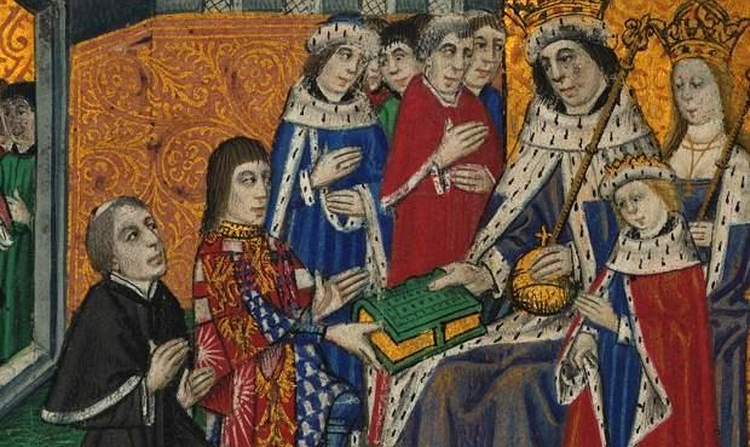
Do you think it is significant that none of the pretenders during Henry VII’s reign claimed to be Edward V?
David Baldwin: It is certainly curious that all the leading pretenders claimed to be either Richard of York or Edward of Warwick and not Edward V. It is as though there was a general acceptance that Edward V was dead, but a corresponding willingness to believe that Richard could still be alive.
Annette Carson: We don’t know this for a fact, but Sir George Buck (1619) believed it and was convinced that Edward V died of natural causes, though there is nothing in the sources to suggest he was sick. Mancini records that he was depressed and believed he was facing death: he had spoken with the boy’s physician, so if there was any physical illness Mancini would have recorded this important information for his masters at the French court. Assuming that the brothers were sent into hiding abroad, it is my firm belief that they would have been separated. The reliably recorded proclamation of ‘Perkin’ in 1496 did not mention his brother at all.
Toni Mount: The boy crowned in Dublin cathedral before the Lambert Simnel rebellion was named as King Edward and used Edward V’s seal on documents he signed in Ireland although he doesn’t seem to have been referred to as Edward V by name as far as we know. Once he was ‘gone’ no one else would try to use that designation.
Josephine Wilkinson: I do think it is significant for the same reasons it is significant that Perkin Warbeck claimed to be (or was believed to be) Richard of York. I think it plausible that Edward died of illness or an accident. If it he did die in an accident, it most probably occurred as he was being taken out of the Tower to a safe place or shortly after that time.
 David Baldwin is a Fellow of the Royal Historical Society who devised and taught courses for adults at the Universities of Leicester and Nottingham for more than twenty years. His 2002 biography Elizabeth Woodville, Mother of the Princes in the Tower) has been reprinted many times, and his other books include Stoke Field. The Last Battle of the Wars of the Roses (Pen & Sword, 2006), The Lost Prince, The Survival of Richard of York (The History Press, 2007), The Kingmaker’s Sisters, Six Women in the Wars of the Roses (The History Press, 2009), The Women of the Cousins’ War [with Philippa Gregory and Michael Jones] (Simon & Schuster, 2011), Richard III (Amberley, 2012), and Richard III, The Leicester Connection (Pitkin, 2013)David Baldwin on Facebook David Baldwin is a Fellow of the Royal Historical Society who devised and taught courses for adults at the Universities of Leicester and Nottingham for more than twenty years. His 2002 biography Elizabeth Woodville, Mother of the Princes in the Tower) has been reprinted many times, and his other books include Stoke Field. The Last Battle of the Wars of the Roses (Pen & Sword, 2006), The Lost Prince, The Survival of Richard of York (The History Press, 2007), The Kingmaker’s Sisters, Six Women in the Wars of the Roses (The History Press, 2009), The Women of the Cousins’ War [with Philippa Gregory and Michael Jones] (Simon & Schuster, 2011), Richard III (Amberley, 2012), and Richard III, The Leicester Connection (Pitkin, 2013)David Baldwin on Facebook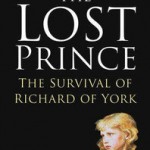 The Lost Prince: The Survival of Richard of York by David Baldwin, published by History Press 2009. Buy The Lost Prince by David Baldwin |
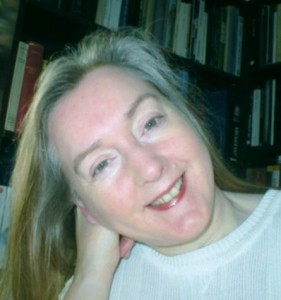 Dr Josephine Wilkinson is an author and historian. Her books include the She received a First from the University of Newcastle where she also read for her PhD. She has received British Academy funding for her research into Richard III’s early life and has been scholar-in-residence at St Deiniol’s Library, Britain’s only residential library founded by the great Victorian statesman, William Gladstone. She now lives in York, Richard III’s favourite city. She is the author of a two volume biography of Richard III, the first volume of which, Richard III, the Young King To Be, has been published by Amberley. She is currently writing volume two. Other books are Mary Boleyn: The True Story of Henry VIII’s Favourite Mistress, The Early Loves of Anne Boleyn and The Princes in the Tower.Josephine’s website Josepha Josephine Wilkinson Dr Josephine Wilkinson is an author and historian. Her books include the She received a First from the University of Newcastle where she also read for her PhD. She has received British Academy funding for her research into Richard III’s early life and has been scholar-in-residence at St Deiniol’s Library, Britain’s only residential library founded by the great Victorian statesman, William Gladstone. She now lives in York, Richard III’s favourite city. She is the author of a two volume biography of Richard III, the first volume of which, Richard III, the Young King To Be, has been published by Amberley. She is currently writing volume two. Other books are Mary Boleyn: The True Story of Henry VIII’s Favourite Mistress, The Early Loves of Anne Boleyn and The Princes in the Tower.Josephine’s website Josepha Josephine Wilkinson The Princes in the Tower: Did Richard III Murder His Nephews, Edward V & Richard of York? by Josephine Wilkinson. Published by Amberley Publishing 2013. The Princes in the Tower: Did Richard III Murder His Nephews, Edward V & Richard of York? by Josephine Wilkinson. Published by Amberley Publishing 2013.Buy The Princes in the Tower by Josephine Wilkinson |
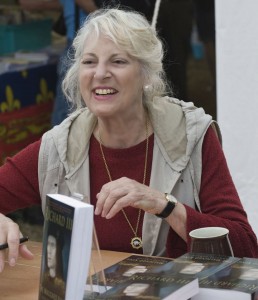 Annette Carson is a freelance writer with a preference for history and biography. She is an award-winning copywriter, has sold over 46,000 non-fiction books on subjects including music and aviation, and has contributed to Encyclopædia Britannica. Her interest in Richard III has been lifelong. She is the author of Richard III: The Maligned King (The History Press) and Richard III: A Small Guide to the Great Debate, aimed at setting out the controversy for the general reader. When Philippa Langley originated the quest for King Richard’s grave, she cited The Maligned King as one of her inspirations and asked Annette to join the team as historical consultant. Annette is still active in the Looking For Richard Project and has been working on editing and publishing ‘Finding Richard III: The Official Account’, due to be available soon.Annette’s website annettecarson.co.uk and Facebook Page Annette Carson is a freelance writer with a preference for history and biography. She is an award-winning copywriter, has sold over 46,000 non-fiction books on subjects including music and aviation, and has contributed to Encyclopædia Britannica. Her interest in Richard III has been lifelong. She is the author of Richard III: The Maligned King (The History Press) and Richard III: A Small Guide to the Great Debate, aimed at setting out the controversy for the general reader. When Philippa Langley originated the quest for King Richard’s grave, she cited The Maligned King as one of her inspirations and asked Annette to join the team as historical consultant. Annette is still active in the Looking For Richard Project and has been working on editing and publishing ‘Finding Richard III: The Official Account’, due to be available soon.Annette’s website annettecarson.co.uk and Facebook Page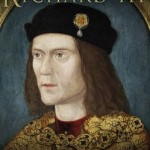 Richard III: The Maligned King by Annette Carson. Published by The History Press 2013. Richard III: The Maligned King by Annette Carson. Published by The History Press 2013.Buy Richard III: The Maligned King by Annette Carson |
 I’m an author, a history teacher, an experienced speaker – and an enthusiastic life-long-learner. I’m a member of the Research Committee of the Richard III Society and a library volunteer where I lead a Creative Writing group. I earned my research MA from the University of Kent in 2009 through study of a medieval medical manuscript held at the Wellcome Library in London, my BA (with First-class Honours) and my Diploma in European Humanities are from the Open University. I have written and published books including The Medieval Housewife and Women of the Middle-ages, and Richard III King of Controversy plus books on Mrs Beeton and Victorian women doctors. My latest book for Amberley Publishing covers the history of London from 500 – 1500 AD. Everyday Life in Medieval London was published in March 2014, and now I’m working on another two medieval books for Amberley for later this year.Toni’s website tonimount.co.uk and Facebook page. I’m an author, a history teacher, an experienced speaker – and an enthusiastic life-long-learner. I’m a member of the Research Committee of the Richard III Society and a library volunteer where I lead a Creative Writing group. I earned my research MA from the University of Kent in 2009 through study of a medieval medical manuscript held at the Wellcome Library in London, my BA (with First-class Honours) and my Diploma in European Humanities are from the Open University. I have written and published books including The Medieval Housewife and Women of the Middle-ages, and Richard III King of Controversy plus books on Mrs Beeton and Victorian women doctors. My latest book for Amberley Publishing covers the history of London from 500 – 1500 AD. Everyday Life in Medieval London was published in March 2014, and now I’m working on another two medieval books for Amberley for later this year.Toni’s website tonimount.co.uk and Facebook page.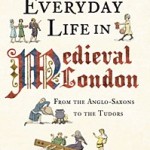 Everyday Life in Medieval London: From the Anglo-Saxons to the Tudors by Toni Mount, published by Amberley Publishing 2014. Everyday Life in Medieval London: From the Anglo-Saxons to the Tudors by Toni Mount, published by Amberley Publishing 2014.Buy Everyday Life in Medieval London by Toni Mount |

